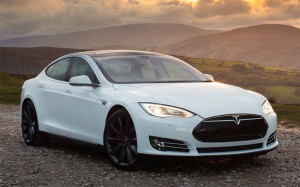Tesla had some mixed news for investors as it revealed its second-quarter results Wednesday afternoon. The maker’s loss was less than anticipated by industry analysts, but the maker fell short of expected vehicle deliveries and cut its forecast for the full year.
The news sent the California battery-carmaker’s shares tumbling in after-hours trading. A critical test in the coming months will be the long-overdue roll-out of the Model X sport-utility vehicle, which Tesla CEO and founder Elon Musk acknowledged was “challenging.”
“Some things are particularly challenging,” he said during a conference call with media and analysts, “But I think it’s going to be the best vehicle in the world and I think it’s going to blow people away.”
On a non-GAAP basis, Tesla reported second-quarter non-GAAP of $1.19 billion, a slight bit ahead of the Wall Street consensus estimate of $1.18 billion. The maker cut its losses to $61 million from a deficit of $148 million during the April-June quarter last year. That translated into a $0.48 per share loss, compared to the $0.60 consensus estimate from Factset.
(Tesla announces first incentive program – with a social spin. Click Here for details.)

Tesla CEO Musk cautioned that getting ready for the launch of the Model X SUV has been "challenging."
Despite what CEO Musk noted were “two price increases in the past six months,” Tesla saw a 30% increase in year-over-year orders in the U.S., European demand rising 50%. The maker delivered 11,532 vehicles during the quarter but forecast it will only deliver 50,000 to 55,000 vehicles for all of 2015, down from the previous forecast of 55,000.
Next year, however, Musk said he expected to see weekly production climb to an average 1,500 to 1,800 vehicles once the Model X is up to full line rate, slightly short of potential capacity of about 2,000 vehicles. Initially, the mix is likely to be “slightly more in the direction of the (Model) X because people have been waiting so long,” said Musk. “It could move 60-40 (percent) in either direction at any given time.”
The Tesla founder stressed that there could be a variety of ongoing challenges in the Model X launch, and that the focus will be on ensuring the new battery SUV’s quality.
“Simply put, in a choice between a great product or hitting quarterly numbers, we will take the former,” he said.
(Forget “Insane Mode.” Tesla now adds “Luuudicrous Mode” to the Model S. Click Here to find out what it does.)
Tesla is already working on two more product lines, including a second-generation roadster and its first mainstream product, the Model III. Musk hinted that the design of that smaller sedan will be revealed during the first quarter of 2016.
The Silicon Valley carmaker has been trying to build its global market and the upturn in European orders is a promising turn after a slow start. But Tesla is still struggling in another key overseas effort.
Musk noted making inroads in China has been a problem for Tesla, in part, because of restrictions in some large cities on new vehicle registrations. The maker has received an exemption that many cities there offer for clean technology vehicles, but not yet in the capital city of Beijing.
Meanwhile, the Tesla CEO said the company is moving ahead in its upcoming launch of a second major business line, the stationary powerpack business, dubbed Tesla Energy, it unveiled earlier this year. The goal is to start producing those storage systems during the current quarter. So far, Musk said “over 100,000 reservations have been placed,” though he cautioned those are not firm orders.
The goal is to deliver 40,000 to 50,000 of the devices in the fourth quarter and perhaps 10 times that number next year.
(Chevy says 2nd-generation Volt plug-in will get 53 miles per charge, a 40% bump. Click Herefor more.)
But Tesla’s primary focus will still be on its automotive business, and Musk said his goal is to significantly increase volumes to at least 500,000 vehicles annually. Cautioning that he was just speculating about the future, Musk suggested that Tesla would eventually need more than just its one car plant in Fremont, California.
Over a “three to five-year timeframe,” he said, “it’s going to make sense for us to localize production, to have a factory in Europe, a factory in Asia, other factories in North America…to go beyond the 500,000 level.”


I guess making cars is kinda hard after all
Selling an impractical product is more difficult than building it.